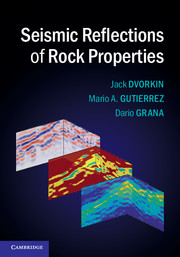Refine listing
Actions for selected content:
1211 results in Ebooks in petroleum sciences
2 - Optimal competence allocation for the EU ETS
-
- Book:
- The Allocation of Regulatory Competence in the EU Emissions Trading Scheme
- Published online:
- 05 July 2014
- Print publication:
- 17 April 2014, pp 75-107
-
- Chapter
- Export citation
Series editors’ preface
-
-
- Book:
- The Allocation of Regulatory Competence in the EU Emissions Trading Scheme
- Published online:
- 05 July 2014
- Print publication:
- 17 April 2014, pp ix-x
-
- Chapter
- Export citation
Chapter 9 - Seismic trace inversion
-
- Book:
- Seismic Amplitude
- Published online:
- 05 June 2014
- Print publication:
- 17 April 2014, pp 197-220
-
- Chapter
- Export citation
Chapter 5 - Rock properties and AVO
-
- Book:
- Seismic Amplitude
- Published online:
- 05 June 2014
- Print publication:
- 17 April 2014, pp 58-109
-
- Chapter
- Export citation
Acknowledgements
-
- Book:
- The Allocation of Regulatory Competence in the EU Emissions Trading Scheme
- Published online:
- 05 July 2014
- Print publication:
- 17 April 2014, pp xi-xiii
-
- Chapter
- Export citation
Tables
-
- Book:
- The Allocation of Regulatory Competence in the EU Emissions Trading Scheme
- Published online:
- 05 July 2014
- Print publication:
- 17 April 2014, pp xxv-xxvi
-
- Chapter
- Export citation
Bibliography
-
- Book:
- The Allocation of Regulatory Competence in the EU Emissions Trading Scheme
- Published online:
- 05 July 2014
- Print publication:
- 17 April 2014, pp 224-248
-
- Chapter
- Export citation
The Allocation of Regulatory Competence in the EU Emissions Trading Scheme - Half title page
-
- Book:
- The Allocation of Regulatory Competence in the EU Emissions Trading Scheme
- Published online:
- 05 July 2014
- Print publication:
- 17 April 2014, pp i-i
-
- Chapter
- Export citation
Chapter 4 - Well to seismic ties
-
- Book:
- Seismic Amplitude
- Published online:
- 05 June 2014
- Print publication:
- 17 April 2014, pp 38-57
-
- Chapter
- Export citation
1 - From competing jurisdictions to competing competences
-
- Book:
- The Allocation of Regulatory Competence in the EU Emissions Trading Scheme
- Published online:
- 05 July 2014
- Print publication:
- 17 April 2014, pp 18-74
-
- Chapter
- Export citation

Seismic Reflections of Rock Properties
-
- Published online:
- 05 April 2014
- Print publication:
- 13 March 2014
1 - Forward modeling of seismic reflections for rock characterization
- from Part I - The basics
-
- Book:
- Seismic Reflections of Rock Properties
- Published online:
- 05 April 2014
- Print publication:
- 13 March 2014, pp 3-12
-
- Chapter
- Export citation
Part III - From well data and geology to earth models and reflections
-
- Book:
- Seismic Reflections of Rock Properties
- Published online:
- 05 April 2014
- Print publication:
- 13 March 2014, pp 113-114
-
- Chapter
- Export citation
Part I - The basics
-
- Book:
- Seismic Reflections of Rock Properties
- Published online:
- 05 April 2014
- Print publication:
- 13 March 2014, pp 1-2
-
- Chapter
- Export citation
12 - DHI validation and prospect risking
- from Part IV - Frontier exploration
-
- Book:
- Seismic Reflections of Rock Properties
- Published online:
- 05 April 2014
- Print publication:
- 13 March 2014, pp 197-204
-
- Chapter
- Export citation
8 - Log shapes at the well scale and seismic reflections in clastic sequences
- from Part III - From well data and geology to earth models and reflections
-
- Book:
- Seismic Reflections of Rock Properties
- Published online:
- 05 April 2014
- Print publication:
- 13 March 2014, pp 132-152
-
- Chapter
- Export citation
Preface
-
- Book:
- Seismic Reflections of Rock Properties
- Published online:
- 05 April 2014
- Print publication:
- 13 March 2014, pp xiii-xvi
-
- Chapter
- Export citation
16 - Gas hydrates*
- from Part V - Advanced rock physics: diagenetic trends, self-similarity, permeability, Poisson’s ratio in gas sand, seismic wave attenuation, gas hydrates
-
- Book:
- Seismic Reflections of Rock Properties
- Published online:
- 05 April 2014
- Print publication:
- 13 March 2014, pp 262-274
-
- Chapter
- Export citation
Appendix - Direct hydrocarbon indicator checklist
-
- Book:
- Seismic Reflections of Rock Properties
- Published online:
- 05 April 2014
- Print publication:
- 13 March 2014, pp 308-311
-
- Chapter
- Export citation
Acknowledgments
-
- Book:
- Seismic Reflections of Rock Properties
- Published online:
- 05 April 2014
- Print publication:
- 13 March 2014, pp xvii-xviii
-
- Chapter
- Export citation
